The Patch and Remediation Software Market is estimated to be valued at USD 1.7 billion in 2025 and is projected to reach USD 7.5 billion by 2035, registering a compound annual growth rate (CAGR) of 16.2% over the forecast period.
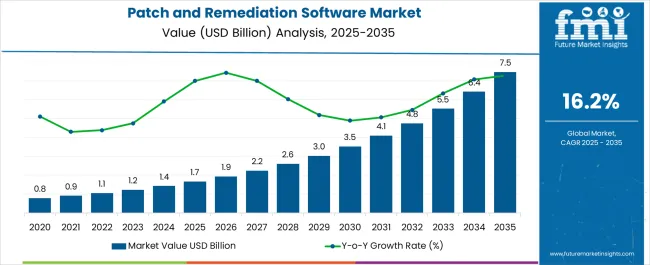
| Metric | Value |
|---|---|
| Patch and Remediation Software Market Estimated Value in (2025 E) | USD 1.7 billion |
| Patch and Remediation Software Market Forecast Value in (2035 F) | USD 7.5 billion |
| Forecast CAGR (2025 to 2035) | 16.2% |
The patch and remediation software market is experiencing robust expansion due to the increasing frequency of cyber threats, vulnerabilities in IT systems, and the rising need for automated security solutions. Organizations across industries are prioritizing timely vulnerability management to safeguard sensitive data and ensure compliance with regulatory frameworks.
Advancements in automation, artificial intelligence, and cloud-based platforms are improving the efficiency of patch deployment and reducing downtime. Growing adoption of remote work models has further amplified the importance of comprehensive patch and remediation solutions to secure distributed IT infrastructures.
With heightened focus on operational resilience and proactive cybersecurity strategies, the market outlook remains highly favorable, encouraging both large enterprises and SMEs to integrate these tools into their security frameworks.
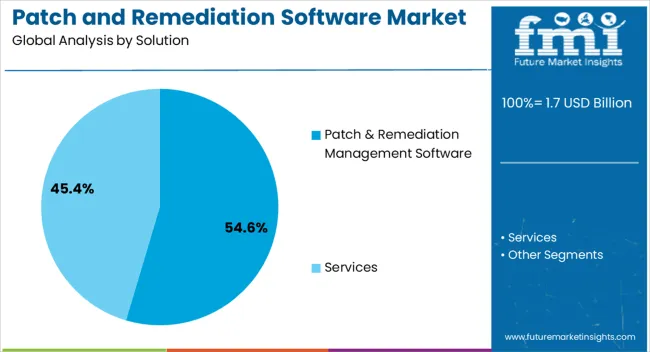
The patch and remediation management software segment is projected to hold 54.60% of total market revenue by 2025 within the solution category, making it the leading segment. This dominance is attributed to its ability to automate vulnerability identification, streamline patch deployment, and minimize security risks across complex IT environments.
Enterprises are increasingly relying on these tools to address compliance mandates and reduce the risk of cyberattacks associated with unpatched systems. Enhanced functionality such as centralized dashboards, real time alerts, and integration with endpoint security solutions has strengthened adoption.
As the scale and complexity of IT networks expand, this solution remains the preferred choice for organizations seeking efficiency, reliability, and improved cybersecurity posture.
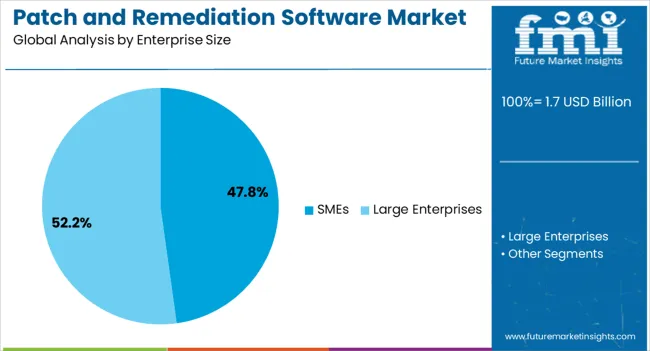
The SMEs segment is expected to contribute 47.80% of total market revenue by 2025 within the enterprise size category, positioning it as a dominant segment. This share is driven by the growing recognition among small and medium businesses of the importance of proactive vulnerability management despite limited IT budgets.
Cloud based and subscription driven patch management solutions have made adoption cost effective and scalable for SMEs. Increasing exposure to cyber threats and the need to comply with data protection regulations are further encouraging SMEs to invest in automated patch and remediation tools.
With solutions becoming more user friendly and tailored to resource constrained organizations, SMEs continue to expand their share in the market by prioritizing security and compliance without incurring excessive costs.
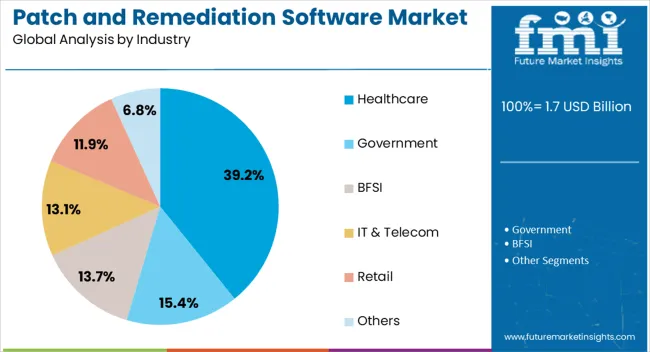
The healthcare industry segment is projected to hold 39.20% of total market revenue by 2025 under the industry category, making it the largest vertical. This dominance is supported by the critical nature of patient data security, stringent regulatory frameworks, and the growing incidence of cyberattacks targeting healthcare providers.
Hospitals, clinics, and research institutions are increasingly adopting patch and remediation solutions to secure connected devices, electronic health records, and cloud based applications. The rising digitalization of healthcare operations and integration of telehealth services have further amplified the demand for robust vulnerability management.
By ensuring compliance with healthcare data protection standards and minimizing the risk of breaches, patch and remediation software has become indispensable in this sector, cementing healthcare’s position as a leading industry in market adoption.
According to latest research by Future Market Insights, the Patch and Remediation Software market is estimated to reach around USD 7.5.0 Bn by 207.51 with an expected CAGR of 10%. The increasing software vulnerabilities will provide opportunities in near future, along with emerging use of automation solution, that will drive the market growth.
The majority of cyber-attackers take advantage of software vulnerabilities, to exploit system data. According to Verizon Data Breach Investigations Report, around 70% of successful cyberattacks exploited known vulnerabilities with available patches. So it is important to update the OS and applications regularly to prevent such attacks.
The demand for updated OS and applications is increasing as updates make computer or devices safer and help in keeping hackers away from exploiting vulnerable spots. Increasing demand for updated OS and applications is driving the patch and remediation software market.
Patch and remediation software can help to fix the code that allow hackers to install damaging malware that can delete important files or information on the computer or devices. Patch and remediation software helps to keep machines up-to-date, safe from malware and stable.
Video games use cutting-edge technologies comprising advanced hardware and software to deliver a compelling entertainment experience to the users. The gaming market is growing continuously, and is expected to continue its expansion in the foreseeable future. Gaming companies are adopting patch and remediation software to monitor and report missing or operation-critical patches and for updating the gaming software or application regularly.
Moreover, online gamers have to deal with common threats, such as malware-wrapped game installers, and thus, gaming companies are investing heavily in cyber threat counter measures, and are adopting patch and remediation software to pursue market expansion by releasing games on a larger number of platforms to attract more people to play.
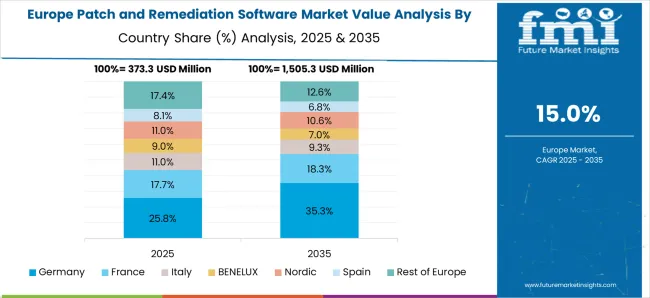
In Europe there have been a number of high profile government initiatives to spur the digital health system. According to UK's National Health Service (NHS), the usage of digital healthcare services soared in 2024, according to data compiled by NHS Digital.
The healthcare industry has become one of the most targeted sectors for cyber-attacks, due to increasing usage of healthcare related software and applications. These software and application store confidential and personal information of patients, doctors and staff. Data stolen from the medical industry includes information related to patients, their medical history, bills, and other records, which can be misused by cyber criminals to create fake IDs for claiming insurance or additional gains.
Moreover, due to the increased usage of various software and applications like remote patient monitoring, healthcare information system (HIS), and others in the healthcare industry, the data protection become critical. The information is stored on cloud which do not offer appropriate security, and are prone to viruses and cyber-attacks.
Thus, to combat such cyber threats, many healthcare organizations are adopting patch and remediation software for regularly updating the software and applications and to prevent the critical information of patients and staff.
Organizations of all sizes in the APAC region are embracing digital transformation, resulting in an explosion of new software, platforms, applications, devices, and technologies, including cloud, SaaS, mobile, IoT, and devOps.
Growing digitization in countries such as Indian, Japan, Singapore, Indonesia and others, has broadened the ways for new cyber threats, and this is prompting enterprises to opt for newer and better security solutions which help them to get the visibility and focus required on closing the cyber exposure gap against a modern attack surface.
Digitization has resulted in the emergence of multichannel integration and various customer interfaces that are vulnerable. Hence, it is vital for enterprises to stay ahead on security by protecting information with patch and remediation software.
Thus, growing digitization has created potential opportunities for patch and remediation software which help in monitoring and managing the modern attacks and reduce the risk of cyber threats.

Some of the leading patch and remediation software providers include
Patch and remediation software vendors adopt various expansion strategies for enhancing their presence and increasing the market share in the global market. The strategies that patch and remediation software follow include acquisitions, partnership and collaborations with other players, new product launches, and strengthening of regional and global distribution networks.
The report is a compilation of first-hand information, qualitative and quantitative assessment by industry analysts, inputs from industry experts and industry participants across the value chain. The report provides in-depth analysis of parent market trends, macro-economic indicators and governing factors along with market attractiveness as per segments.
The report also maps the qualitative impact of various market factors on market segments and geographies.
The global patch and remediation software market is estimated to be valued at USD 1.7 billion in 2025.
The market size for the patch and remediation software market is projected to reach USD 7.5 billion by 2035.
The patch and remediation software market is expected to grow at a 16.2% CAGR between 2025 and 2035.
The key product types in patch and remediation software market are patch & remediation management software, services, _security patching & support, _security consulting and _implementation services.
In terms of enterprise size, smes segment to command 47.8% share in the patch and remediation software market in 2025.






Full Research Suite comprises of:
Market outlook & trends analysis
Interviews & case studies
Strategic recommendations
Vendor profiles & capabilities analysis
5-year forecasts
8 regions and 60+ country-level data splits
Market segment data splits
12 months of continuous data updates
DELIVERED AS:
PDF EXCEL ONLINE
Patchouli Oil Market Size, Growth, and Forecast for 2025 to 2035
Foot Patches Market Size and Share Forecast Outlook 2025 to 2035
Pain Patches Market
Period Patch Market Trends – Demand, Growth & Forecast 2025 to 2035
Sensor Patches Market Analysis - Growth, Applications & Outlook 2025 to 2035
Period Patch Market Share Analysis
Vitamin Patches Market - Size, Share, and Forecast Outlook 2025 to 2035
Insulin Patch Pump Market
Vascular Patches Market Forecast and Outlook 2025 to 2035
Train Dispatching Market Size and Share Forecast Outlook 2025 to 2035
Global Under-Eye Patches Market Size and Share Forecast Outlook 2025 to 2035
Tire Repair Patch Market Analysis By Type, Application, and Region Through 2035
Tattoo Removal Patch Market
Non-opioid Pain Patches Market Size and Share Forecast Outlook 2025 to 2035
Electronic Skin Patch Market Size and Share Forecast Outlook 2025 to 2035
Market Share Insights for Anti-Acne Dermal Patch Providers
Anti-acne Dermal Patch Market Insights – Trends & Forecast 2024-2034
Transdermal Cosmetic Patches Market Size and Share Forecast Outlook 2025 to 2035
Wearable Defibrillator Patch Market Analysis - Size, Share, and Forecast Outlook 2025 to 2035
Self - Adhesive Carton Window Patch Machine Market

Thank you!
You will receive an email from our Business Development Manager. Please be sure to check your SPAM/JUNK folder too.
Chat With
MaRIA